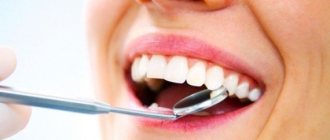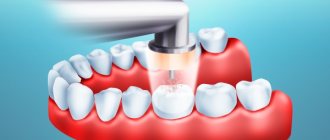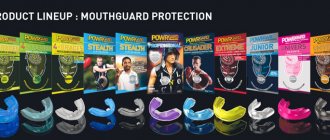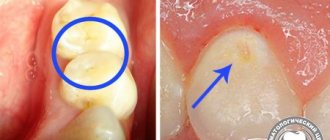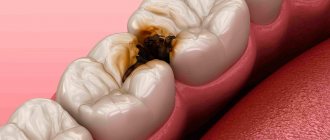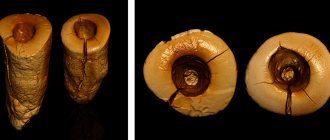Almost every inhabitant of the planet suffers from caries, and many people are afraid of preparing teeth with a drill. In this regard, modern conservative treatment methods, which allow you to cure a tooth without surgical intervention, are of particular relevance. One of these methods is ICON - we’ll explain what it is and how it works in the article.
In this article
- What are caries?
- What is microinvasive caries treatment and when is it used?
- Treatment of caries using the ICON method - what is this technology?
- How is caries treatment performed using the Icon method?
- When is it prohibited to use the technique?
- Treatment with the ICON method: main advantages
Methods for treating caries without drilling
Getting rid of caries without using a drill is the dream of every dental patient.
Not so long ago, it seemed absolutely unattainable. But technology is developing, new, more gentle, effective methods are constantly appearing. Today, treating caries without drilling is a completely common procedure. From a clinical point of view, caries is divided into 4 main stages of development. Gentle treatment methods, without the use of a drill, are used only in the initial stages of the disease, when the carious lesion has not penetrated deeper than the enamel. New technologies make it possible to stop the pathological process when a cavity has just begun to form in the fissure, without waiting for further destruction of dental tissue. Treatment of caries without a drill is carried out using the infiltration method, using ozone therapy, laser, and air abrasive effects.
Comfortable service
Communication with the doctor reaches a whole new level. You will not be frightened by creepy, incomprehensible terms and dangerous operations. The doctor will be able to show the planned stages of treatment of your teeth on the computer screen in the form of an interactive video and discuss all the points with you. Visits to the dentist will be comfortable and calm.
As you can see, the latest trends in medicine make it possible to simply and quickly solve the most unpleasant and seemingly complex problems. Taking care of your oral health and the beauty of your smile is very easy; all you need to do is consult a doctor on time and be attentive to your feelings.
ICON or liquid filling
The infiltration method of treatment (ICON) consists of using a special light-composite polymer, which fills the pores of the enamel, sealing the affected area. The treatment mechanism is quite simple:
- The carious lesion is covered with a special gel that splits the surface enamel layer (enamel etching).
- After removing the gel, the tooth surface is dried, and a polymer material is applied to fill the porous structure of the enamel, blocking the path for the spread of bacteria that cause caries.
- The infiltrate is polymerized using a special lamp.
The ICON treatment method does not require mechanical action on dental tissue. The procedure is painless, lasts 10-15 minutes, and is used to eliminate superficial caries. Excellent for patients who are contraindicated for anesthesia - allergy sufferers, children, pregnant women.
Sources
- Al-Obaidi R., Salehi H., Collart-Dutilleul PY., Jacquot B., Tassery H., Cuisinier FJG., Gergely C., Cloitre T. Relationship between Changes in Chemical Composition of Enamel Subsurface Lesions and the Emitted Nonlinear Optical Signals: An in vitro Study. // Caries Res - 2021 - Vol54 - N2 - p.144-153; PMID:32107346
- Al-Obaidi R., Salehi H., Desoutter A., Tassery H., Cuisinier F. Formation and assessment of enamel subsurface lesions in vitro. // J Oral Sci - 2021 - Vol61 - N3 - p.454-458; PMID:31341119
- Innes NPT., Chu CH., Fontana M., Lo ECM., Thomson WM., Uribe S., Heiland M., Jepsen S., Schwendicke F. A Century of Change towards Prevention and Minimal Intervention in Cariology. // J Dent Res - 2021 - Vol98 - N6 - p.611-617; PMID:31107140
- Yucesoy DT., Fong H., Gresswell C., Saadat S., Chung WO., Dogan S., Sarikaya M. Early Caries in an In Vivo Model: Structural and Nanomechanical Characterization. // J Dent Res - 2021 - Vol97 - N13 - p.1452-1459; PMID:30067915
- Mira A. Oral Microbiome Studies: Potential Diagnostic and Therapeutic Implications. // Adv Dent Res - 2021 - Vol29 - N1 - p.71-77; PMID:29355422
- Ogretme MS., AbualSaoud D., Hosey MT. What preventive care do sedated children with caries referred to specialist services need? // Br Dent J - 2021 - Vol221 - N12 - p.777-784; PMID:27981972
- Nazemisalman B., Farsadeghi M., Sokhansanj M. Types of Lasers and Their Applications in Pediatric Dentistry. // J Lasers Med Sci - 2015 - Vol6 - N3 - p.96-101; PMID:26464775
- van der Veen M.H. Detecting Short-Term Changes in the Activity of Caries Lesions with the Aid of New Technologies. // Curr Oral Health Rep - 2021 - Vol2 - N2 - p.102-109; PMID:26317065
- Zotti F., Dalessandri D., Salgarello S., Piancino M., Bonetti S., Visconti L., Paganelli C. Usefulness of an app in improving oral hygiene compliance in adolescent orthodontic patients. // Angle Orthod - 2021 - Vol86 - N1 - p.101-7; PMID:25799001
- Chambers C., Stewart S., Su B., Sandy J., Ireland A. Prevention and treatment of demineralization during fixed appliance therapy: a review of current methods and future applications. // Br Dent J - 2013 - Vol215 - N10 - p.505-11; PMID:24264666
Ozone treatment
The technique is based on the effect of ozone on the carious lesion. A special cap connected to ozone therapy equipment is put on the tooth. Exposure to ozone has a detrimental effect on pathogens. After disinfection, a special sealing agent is applied to the affected area. This method is used to treat caries in the spot stage, fissure, and molar surface caries. Ozone therapy is used for antiseptic treatment of carious cavities at any stage of the disease, as well as in the treatment of gingivitis, periodontitis and other periodontal pathologies.
Treatment of wedge-shaped defect and treatment of cervical caries with ceramic inlays.
This technique is a premium one. Its distinctive feature is that the cavity in the tooth is closed not with a light-colored restoration material, but with a ceramic inlay. The service life of this ceramic inlay is about 25 years. In terms of aesthetic parameters, it is completely indistinguishable from natural tooth tissue.
Restoring a wedge-shaped defect or cervical caries with a ceramic inlay has several advantages:
- biocompatibility of the material from which the inlay is made. Lithium disilicate, the restoration material in this case, is called synthetic enamel in Germany.
- high aesthetics: the inlay is not noticeable on the tooth due to the chameleon effect that is inherent in lithium disilicate.
- long-lasting shine and no need for periodic polishing.
- Super smooth surface prevents the accumulation of plaque and tartar.
- service life up to 25 years due to the special strength of lithium disilicate.
IN THE PHOTO: AN EXAMPLE OF TREATMENT OF A WEDGE-shaped TOOTH DEFECT AT THE BIONIC DENTIS DENTAL CLINIC. BEFORE AND AFTER TREATMENT.
The process of treating a wedge-shaped defect or cervical caries using a ceramic inlay consists of the following steps:
First visit to the clinic:
- A topical anesthetic gel is applied to the patient’s gums to reduce the sensitivity of the mucous membrane.
- the treatment area is anesthetized by injection of Ultracaine, which makes all manipulations 100% painless.
- Using a turbine and a dental diamond bur, softened, pigmented and infected tooth tissues are cleaned and a place is formed for the placement of the inlay.
- the bottom and walls of the cavity are processed using a dental laser for sterilization.
- The tooth surface of the tooth is treated with a 7th generation adhesive system.
- Impressions are taken from the dentition using silicone impression material or a 3D scanner for transfer to the laboratory.
- a tooth enamel defect in the cervical area is restored with a temporary filling.
IN THE PHOTO: AN EXAMPLE OF TREATMENT OF CERVICAL TOOTH CARIES AT THE BIONIC DENTIS DENTAL CLINIC. BEFORE AND AFTER TREATMENT.
Second visit to the clinic:
- A topical anesthetic gel is applied to the patient’s gums to reduce the sensitivity of the mucous membrane.
- the treatment area is anesthetized by injection of Ultracaine, which makes all manipulations 100% painless.
- Using a turbine and a dental diamond bur, the temporary filling is removed.
- An inlay made in a dental laboratory is glued into the cavity in the cervical area of the tooth.
- The glue is polymerized using a dental lamp.
- The restoration is polished.
Thus, to make a ceramic inlay for the treatment of a wedge-shaped defect or cervical caries, two visits to the clinic are required. However, the long service life of such a design (several times longer than the service life of the filling) compensates for such a long process.
Each visit takes approximately 40 minutes.
The time between visits is on average 10 days.
The cost of restoration of a wedge-shaped defect or cervical caries of a ceramic inlay made of lithium disilicate is 55,000 rubles.
IN THE PHOTO: AN EXAMPLE OF TREATMENT OF CERVICAL TOOTH CARIES AT THE BIONIC DENTIS DENTAL CLINIC. BEFORE AND AFTER TREATMENT.
These methods for treating wedge-shaped defects and cervical caries within the walls of our clinic will allow you to forget about this problem for many years.
Ozerov Petr Vladimirovich
Chief physician. Dentist, implantologist, orthopedist, surgeon. Laser dentistry specialist
More details
Werner Elena Vladimirovna
Dentist periodontist
More details
Eremina Anna Arturovna
Dentist therapist
More details
Laser technologies
Dental tissue preparation is performed non-contactly using a laser. The doctor adjusts the length of the laser beam according to the clinical picture. The radiation affects only the affected tissue, healthy tissue is not involved. Another advantage of the method is the absence of the vibration effect that occurs when the drill is operating. And this eliminates the risk of cracks and chips in the enamel. Laser radiation has a bactericidal effect; after treatment, the carious cavity is absolutely sterile; after filling, the development of secondary caries is excluded.
Treatment without a drill, using laser technologies, can be used both in the initial stages of caries and in cases of noticeable damage to the tooth, when it is necessary to place a filling. The procedure is painless, harmless, and is indicated for patients with special sensitivity, including children and pregnant women.
How will caries be treated in the future?
Diagnostics
The dentistry of the future surprises from the very beginning: a patient is examined here by an “electronic doctor” - a diagnostic complex consisting of a computed tomograph, 3D printer, scanner, microscope and video cameras. The role of the dentist has changed: he no longer needs to, armed with a mirror, bend low over his patient; all the information is quickly and accurately collected by the computer. All that remains for a person to do is analyze it and make the correct diagnosis.
In addition, the doctor must explain the diagnosis to the patient. To do this, he prints a tooth model on a 3D printer, on which the areas affected by caries are marked, and agrees on a treatment plan.
Anesthesia
After this, the dentist begins treatment. The main drug for local anesthesia has not changed - the articaine-based anesthetics that are common today work almost perfectly, nothing has had to be improved here. But in the future, syringes were improved (now they are produced with electronic dispensers; the required dose is calculated individually based on information from each patient’s personal file), and they also use a means to quickly stop the action of anesthesia, the development of which has just begun in our time.
For people who are terrified of injections, an alternative has been proposed - a nasal anesthetic spray. Sprinkle it in your nose - and you can get to work... Such an elegant solution to the problem was proposed these days by scientists from the University of Pennsylvania. Their research showed that nasal anesthesia works great in 88% of patients, so injections are no longer necessary.
Great importance is attached to creating comfortable conditions for the patient and diverting his attention from unpleasant thoughts. Specially selected music, massage chairs, and video glasses await you in the dentistry of the future. And sedation (immersion in medicinal sleep) has been improved so much that patients now receive real pleasure from the dental treatment process, which is what a person experiences from a sweet nap.
Dentistry of the future is nice!
Sealing
Now that the patient has relaxed and dozed off, the dentist gets to work. The doctor treats the carious cavity with a laser, removing the affected dentin and enamel exactly within the healthy tissue.
After this, the tooth is filled. Moreover, the filling in the future has changed a lot - materials based on artificial cement and other fillers that are common today have been abandoned, since they interfere with the restoration of the mineral balance. In the future, a biodegradable collagen sponge with a substance that activates stem cells in the tooth will be used as a filling. The sponge dissolves over time, and instead of it, dentin forms in the tooth, replacing the losses caused by caries. This technology was recently proposed by scientists from King's College of Great Britain in the pages of the scientific journal Scientific Reports.
Prevention
But the main innovation in the dentistry of the future is not in technology, materials or tools, but in the use of information.
The unified electronic database of patients with treatment history, which was created in MediLine today, will be significantly expanded in the future. Now information files on patients are kept from the age of three to four, which allows dentists to develop individual treatment regimens for each person. This approach has already been implemented in the Scandinavian countries and has shown its effectiveness; we can expect that in the next 20-30 years it will spread throughout the world, including here in Russia. The information base allows dentists to create and adjust individual disease prevention programs.
Now all preventive operations (plasty of the frenulum of the upper lip and tongue, vestibuloplasty, etc.) are carried out before the person’s 20th birthday. This approach significantly reduces the number of complex dental cases and will reduce the number of “aesthetic” operations (teeth straightening, whitening, etc.).
In the future, dentistry will not be a medicine of diseases, but a medicine of health.
Prevention of caries
Regular oral hygiene will help maintain dental health. You need to brush your teeth twice a day, using fluoride toothpastes and mouth rinses. Don't forget to use dental floss and irrigator. You can prevent tooth decay by limiting your carbohydrate intake. Sweets, baked goods, and carbonated drinks leave sticky residues that serve as a breeding ground for oral microflora. Bacterial plaque forms faster, which increases the risk of developing caries.
An important condition for caries prevention is visiting the dentist at least 2 times a year for examination and hygienic cleaning. Regular inspections allow you to detect problems at an early stage. In this case, it is possible to treat caries without drilling, using non-invasive technology.
Types of caries in children
- Initial caries. It is characterized by minor changes in the enamel of the teeth, with the appearance of small yellow spots on the surface of the tooth or darkening of the enamel. Initial caries is painless for the child, and can only be recognized visually. At this stage, it is important to begin treatment immediately and prevent further development of inflammation.
- Superficial caries. It is characterized by a significant change in tooth enamel, the appearance of roughness, brown or black spots that are constantly increasing. Teeth begin to react to sour and sweet foods.
- Average caries. Inflammation destroys the enamel and affects the hard tissues of the tooth (dentin), small holes are formed, and the teeth react painfully to cold and hot food.
- Deep caries. The inflammatory process destroys dentin and reaches the pulp, which results in severe pain when eating any food. Most often, advanced deep caries leads to the removal of the affected tooth. Inflammation of the pulp may be accompanied by fever, weakness, and nausea.
In addition, caries varies:
- by location (cervical or planar);
- according to the intensity of the lesion (single or multiple);
- according to developmental characteristics - complicated and uncomplicated, primary or secondary, etc.
In addition to purely dental problems, such as:
- pulpitis (inflammation of the pulp, which can cause a purulent infection);
- early loss of baby teeth, which can lead to malocclusion and other oral problems;
- infection of the buds of permanent teeth located under a diseased tooth (permanent teeth may appear with caries or not grow at all), the inflammatory process in the oral cavity often leads to digestive problems and recurrent diseases of the ENT organs.
